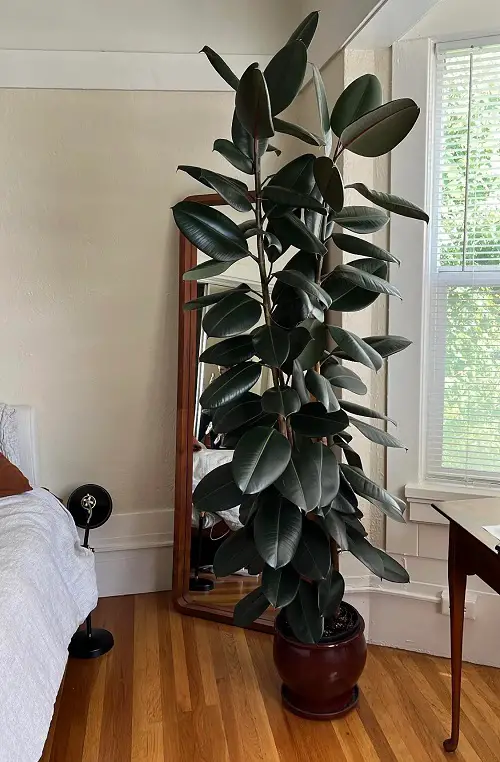Do you want to Grow a Big, Bold, and Tall Rubber Tree Plant in your Home? Well, it’s very much possible 😄 and these tips will help you!
Growing a tall Rubber Tree (Ficus elastica) in your home can transform your space into a tropical delight with its glossy and broad leaves towering to new heights and creating a bold statement!
Learn How to Grow a Big and Tall Dieffenbachia Like a Tree here
How to Grow a Big and Tall Rubber Tree in the Home
1. Choose the Right Rubber Tree Variety
Grow the common rubber tree (Ficus elastica), which works best for growing as a “tree.” However, if you want to bring color to the space, try one of the varieties suggested below:
- Burgundy Rubber Tree (Ficus elastica ‘Burgundy’): It features large, glossy, burgundy-hued leaves, adding a striking visual element to any room. They can achieve a height of 5-7 feet.
- Robusta Rubber Tree (Ficus elastica ‘Robusta’): As its name suggests, ‘Robusta’ is a sturdy variety that can grow quite tall and wide, mimicking a tree-like form.
- Tineke Rubber Tree (Ficus elastica ‘Tineke’): ‘Tineke‘ is the most popular one. It grows upright and can be encouraged to grow tall.
- Decora Rubber Tree (Ficus elastica ‘Decora’): This variety is known for its vertical growth and can be trained to grow wide through pruning.
You can see the best Rubber plant varieties here
2. Keep it Slightly Root Bound Always
Just like many other plants, the rubber tree loves to reside in a slightly root-bound container as well.
When roots are restricted, the plant might allocate more resources to vertical growth to maximize light absorption.
Note: Do not keep it excessively root-bound. If you notice the roots emerging from the topsoil and bottom hole of the pot, re-pot the plant into a container one size bigger than the previous one.
3. Provide Adequate Lighting
This low-maintenance houseplant can survive in the dark, but if you want to grow a big and large rubber tree, provide more light. Place your specimen near a window with filtered sunlight, but avoid exposing it to harsh, direct sunlight for extended periods. Also, rotating the plant every week is a good idea.
Pro Tip: Keeping it exposed to the direct morning sun for 3-4 hours daily will promote its growth like anything!
Find How to Grow a Big Croton Like a Tree in this Guide
4. Give Support
Provide support from the early stage to ensure the plant grows in a vertical manner and doesn’t bend. This will also make the main stem strong, which will eventually help it to take the weight of the top-heavy “tree” like growth in the future.
For support, you can use bamboo or plastic poles or clips.
5. Do Not Overwater
Ficus elastica is very forgiving and doesn’t mind occasional overwatering and underwatering, however, to maintain its best health, keep the growing medium on a slightly drier side and water only when the soil feels a bit dry, you can feel it by touching your finger or use a moisture meter.
Look at the Indoor Plants That Look Like A Banana Tree here
6. Pruning and Shaping
Pruning is the key here if you want to shape the plant as a “tree.” If you want to make it “top heavy,” then make sure you remove the lower leaves and stems on the main thick stem – this will make the plant appear taller and eventually grow a thick canopy.
If you want the plant to have a bushier appearance, keep the stems growing at the bottom and support them at the early stage so that they grow away from the main stem, creating a “shrub” like look like you see in the picture.
Here is a List of Tall Tree Like Houseplants You Should Grow
7. Fertlize Frequently in Weak Dose
Supporting the plant’s growth is important to ensure it thrives. To fertilize, follow the rule of doing it more frequently rather than doing it heavily once a month.
For this, use any general-purpose or balanced liquid fertilizer, dilute it to 1/4 of its recommended strength by the manufacturer, and feed the plant every 14 days (Twice a month). If you live in a warm climate, reduce fertilizing, and if you live in a cool climate with a harsh winter, stop feeding during colder months.) What this does is:
- Ensures a constant supply of nutrients, matching the plant’s growth rate.
- This method supports better root health, leading to more efficient nutrient and water uptake.
- Frequent, light feeding reduces the chances of overfertilization and salt buildup.




